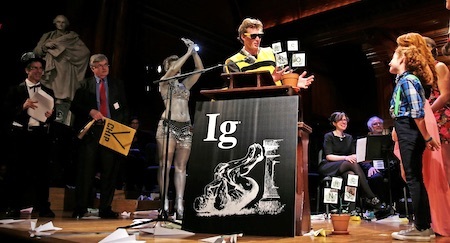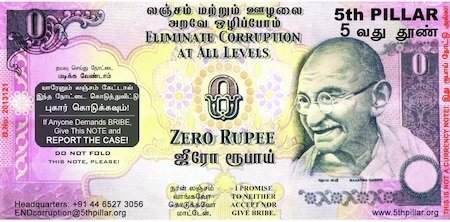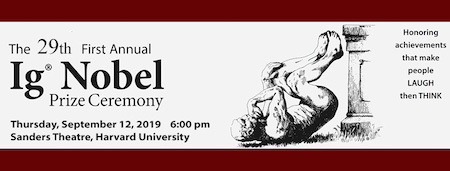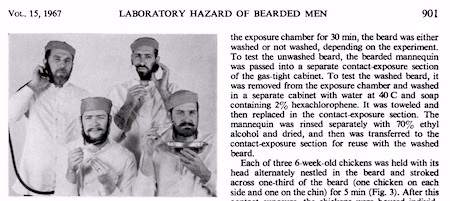Marc Abrahams's Blog, page 143
July 9, 2019
A look back at the 25th First Annual Ig Nobel Prize ceremony
The 25th First Annual Ig Nobel Prize ceremony, in the year 2015, was extra-memorable. Diane Kelly, reporting for Gizmodo, explained why:
The 25th Ig Nobel Awards Were The Greatest Moment In The History of (Silly) Science
For years, the Ig Nobel Awards have been famous for celebrating the most offbeat and ludicrous forms of scientific discovery. And last night, I was lucky enough to attend the 2015 Ig Nobel ceremony, because a friend was the proud winner of an Ig Nobel.
This year was the 25th First Annual Ig Nobel Prize Ceremony, and everyone agreed this was a Very Big Deal. And even though the organizers insisted that this year’s theme, “LIFE,” was not necessarily connected to any of the achievements that were being honored with this year’s prize, a few of the award recipients nevertheless had something to do with biological life. Including sex.
But before the winners were announced, first there were traditions to uphold. The deluge of paper airplanes (in which I managed to nail the announcer with my plane–sorry about that). The “Welcome, welcome” speech, delivered by the very tall Bill Hoston and the height-challenged Jean Berko Gleason. The parade of the new Ig Nobel winners and real Nobel Laureates.
One special treat was a public reunion of all of the young women who have performed the official role of “Miss Sweetie-Poo” for the awards ceremony. Miss Sweetie-Poo is the Ig Nobel timekeeper. If any of the award-acceptance speeches go on too long, an adorable eight-year-old girl marches up to the podium and loudly repeats “Please stop. I’m bored!” until they stop talking….
Here’s recorded video of that ceremony:

July 8, 2019
Using a ‘robot audience’ to induce acute stress [new study]
Psychology researchers : are you looking for a novel way to illicit an acute stress response in your experimental participants? If so, a new paper in the journal Computers in Human Behavior (Volume 99, October 2019, Pages 76-85) may provide ideas. A research team from the University of Bath and Bournemouth University, UK, have devised a new way to cause stress. It involves a 10-min ‘mock interview’ (and mathematics task) held in front of an ‘audience’ of robots.
“Until now, a non-human robot audience has not been used in a social stress testing paradigm.”
– say the team. Their open-access paper can be read in full here : ‘Use of a non-human robot audience to induce stress reactivity in human participants’
An 11 minute video of the robot audience can be found here (.mp4 format) [Advisory : Viewing may cause increases in salivary cortisol]
https://ars.els-cdn.com/content/image/1-s2.0-S0747563219301943-mmc1.mp4
Research research by Martin Gardiner

July 4, 2019
Cockroach oil gets thumbs down for cookery [new study]
 If you’re thinking of supplementing or replacing your plant-based cooking oils with oils made from insects, maybe steer away from Blaptica dubia – the Dubia Cockroach. Stick to mealworms or house crickets instead. That’s the take-home message from a new paper in-press at the Journal of Insects as Food and Feed which details recent progress in evaluating insect-based cooking oils. The research team, from Wageningen University in The Netherlands investigated the potential of yellow mealworms (Tenebrio molitor), lesser mealworms (Alphitobius diaperinus), house crickets (Acheta domesticus) and Dubia cockroaches (Blaptica dubia).
If you’re thinking of supplementing or replacing your plant-based cooking oils with oils made from insects, maybe steer away from Blaptica dubia – the Dubia Cockroach. Stick to mealworms or house crickets instead. That’s the take-home message from a new paper in-press at the Journal of Insects as Food and Feed which details recent progress in evaluating insect-based cooking oils. The research team, from Wageningen University in The Netherlands investigated the potential of yellow mealworms (Tenebrio molitor), lesser mealworms (Alphitobius diaperinus), house crickets (Acheta domesticus) and Dubia cockroaches (Blaptica dubia).
“This study aims to contribute to the knowledge of insect oils that were extracted from insects commercially reared in Europe. Oil was extracted from yellow mealworm, lesser mealworm, house cricket and Dubia cockroach by an aqueous based oil extraction method.
[…]
The extracted insect oil presented a wide range of melting peaks, from -30.7 to 22.7 °C, which makes them liquid-like at room temperature. Its thermal profile shows separated peaks showing that fat fractionation is feasible. Oil colour was bright yellow-reddish. Most oils had compounds related to pleasant aromas, except for Dubia cockroach. In the latter oil several acid compounds related to unpleasant aromas were identified. This study shows that yellow meal worm oil, lesser mealworm oil and cricket oil have characteristics desirable for table oils and for oils use as food ingredients.”
Note: Dubia means “of doubtful origin”, and should not be confused with Dubya or Dubai.
Research research by Martin Gardiner

July 3, 2019
Neither a spender nor a buyer be: The Zero-Rupee Note
Is paper money that has no value of no value? The zero-rupee note, issued in India by non-governmental volunteers, is a way to study that question.
The organization behind the zero-rupee note sees it as a way to fight corruption.
The Wikipedia description boils that down: “The notes are ‘paid’ in protest by angry citizens to government functionaries who solicit bribes in return for services which are supposed to be free. Zero rupee notes… are made to resemble the regular 50 rupee banknote of India.”
A Complementary Approach: Dead Reckoning
A parallel approach to the fight against corruption—specially targeting one especially exquisite form of corruption—is taken by the Association of Dead People.
The Association’s founder, Lal Bahari, was awarded the 2003 Ig Nobel Peace Prize, for triple accomplishment: First, for leading an active life even though he has been declared legally dead; Second, for waging a lively posthumous campaign against bureaucratic inertia and greedy relatives; and Third, for creating the Association of Dead People.
The Association has become persistently active in Indian politics. It is, one might say, a political movement that will not die.
(Thanks to Mark Dionne for bringing this to our attention.)

July 2, 2019
Innovative Scientists Talk About Their Childhood (7): Nicole Sharp and the Paddle Boat
Here’s Nicole Sharp talking about a boat ride that, when she was a child, excited Nicole in a way that led to her eventual unusual career. Nicole created and runs FYFD, the most popular fluid dynamics web site in this part of the universe.
ABOUT THIS LITTLE VIDEO SERIES—This is part of a series of sessions we (David Hu and I, and a film crew) recorded at Georgia Tech. We assembled a little group of scientists (including David) who are renowned for looking at questions others might overlook, and doing research in inventive, clever ways.
The question we asked them: “What happened when you were a kid that somehow led—much later—to your doing unusual science?”
The scientists: David Hu, Suzana Herculano-Houzel, Frans de Waal, Nicole Sharp, Diego Golombek, and Olga Shishkov. Follow the links on their names to begin exploring some of their work!
A FURTHER NOTE ABOUT THIS SERIES: These little videos are not quite as good as they ought to have been, due to curious decisions made by the video editor. The most obvious of those strange decisions was to dose everything with goopy, slightly distracting music. The editor also objected to some of the content of the videos, deeming them somehow too offensive to record. The lesson we learned: choose our video editor more carefully.

July 1, 2019
Ig Nobel ceremony TICKETS go on sale July 10
Tickets for the 29th First Annual Ig Nobel Prize ceremony go on sale Wednesday, July 10, 2019, at NOON (US eastern time), exclusively from the Harvard Box Office.

Improbable Research Table Talk: Hazards of Bearded Men
Join us for a cozy chat about a research study that makes people laugh, then think. This session: The Ig Nobel Prize-winning study “Microbiological Laboratory Hazard of Bearded Men“. Free. Bring friends.
When: Monday, July 8, 2019, 7 pm.
Where: Toscanini’s Ice Cream, 159 First Street, Cambridge, MA, USA.
This continues the Improbable Research Table Talk series that began in summer of 2018.

A multi-aperture pinhole camera using a biscuit [study]
Dr Patrick Cabe who is a member of the emeritus faculty at the University of North Carolina at Pembroke Department of Psychology, is the first to describe how to make a fully functional multi-aperture pinhole camera using a biscuit [‘cracker’ US].
Dr Cabe engaged in a practical demonstration of his camera to (indirectly) view the 2017 solar eclipse.
“To make a viewer for the 2017 eclipse, I cut a hole (approximately 3cm square) in the end of a box (roughly, 60cm long x 38cm x 38cm; dimensions are not critical to effective operation). Over the hole, I taped a snack biscuit (U.S.: cracker), which had a series of holes punched in it. Holes measured approximately 0.8mm in diameter, arranged in a grid with approximately 1cm spacing.”
 See: Multi-Image Pinhole Viewer Using a Biscuit in the journal Perception, Volume: 47 issue: 1, 2018, page(s): 112-114.
See: Multi-Image Pinhole Viewer Using a Biscuit in the journal Perception, Volume: 47 issue: 1, 2018, page(s): 112-114.
Note: The brand of biscuit used was left unspecified in the article.
Research research Martin Gardiner

June 28, 2019
Innovative Scientists Talk About Their Childhood (6): Olga Shishkov’s Maggots
Here’s Olga Shishkov talking about some maggots, and some numbers that, when she was a child, excited Olga in a way that led to her eventual unusual career. Olga studies how maggots manage to do some of the surprising, impressive things they do.
ABOUT THIS LITTLE VIDEO SERIES—This is part of a series of sessions we (David Hu and I, and a film crew) recorded at Georgia Tech. We assembled a little group of scientists (including David) who are renowned for looking at questions others might overlook, and doing research in inventive, clever ways.
The question we asked them: “What happened when you were a kid that somehow led—much later—to your doing unusual science?”
The scientists: David Hu, Suzana Herculano-Houzel, Frans de Waal, Nicole Sharp, Diego Golombek, and Olga Shishkov. Follow the links on their names to begin exploring some of their work!
A FURTHER NOTE ABOUT THIS SERIES: These little videos are not quite as good as they ought to have been, due to curious decisions made by the video editor. The most obvious of those strange decisions was to dose everything with goopy, slightly distracting music. The editor also objected to some of the content of the videos, deeming them somehow too offensive to record. The lesson we learned: choose our video editor more carefully.

June 27, 2019
Authors: can boozing alleviate writer’s cramp? [study]
 “Have you tried taking a stiff drink or two?” might not be a question that a professional writer would expect from their doctor. Unless, that is, they suffered from writer’s cramp, and their doctor had come across a 2012 case report in the journal Internal Medicine – Alcohol-Responsive Writer’s Cramp – in which Sung-Chul Lim, Joong-Seok Kim, Jae-Young An, and Sa Yoon Kang at the Department of Neurology, College of Medicine, of The Catholic University of Korea, South Korea, relate their discovery that (in one case they examined) 400ml of beer could effectively relieve the symptoms of writer’s cramp in just ten minutes. There is, as yet, no generally accepted psycho/biophysical explanation.
“Have you tried taking a stiff drink or two?” might not be a question that a professional writer would expect from their doctor. Unless, that is, they suffered from writer’s cramp, and their doctor had come across a 2012 case report in the journal Internal Medicine – Alcohol-Responsive Writer’s Cramp – in which Sung-Chul Lim, Joong-Seok Kim, Jae-Young An, and Sa Yoon Kang at the Department of Neurology, College of Medicine, of The Catholic University of Korea, South Korea, relate their discovery that (in one case they examined) 400ml of beer could effectively relieve the symptoms of writer’s cramp in just ten minutes. There is, as yet, no generally accepted psycho/biophysical explanation.
“Although the exact mechanism is unknown, alcohol might reverse the pathophysiologic changes in the entire basal ganglia circuit in patients with writer’s cramp.”
LISTINGS :
[1] Some (late) authors who suffered from writer’s cramp :
● J.M. Barrie [pictured]
[2] Some (late) authors who battled alcoholism :
BONUS [joke]
“The cure for writer’s cramp is writer’s block” [unattrib.]
Research research Martin Gardiner

Marc Abrahams's Blog
- Marc Abrahams's profile
- 14 followers







